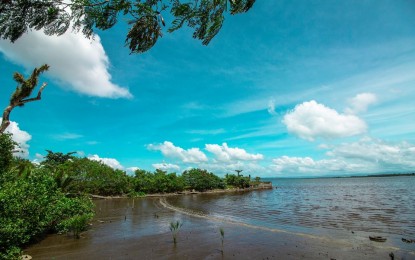
RECURRING. A portion of red tide-infested Cancabato Bay in Tacloban City. The red tide bloom has recurred in Cancabato Bay just two weeks after the lifting of the shellfish ban in the area, the Bureau of Fisheries and Aquatic Resources (BFAR) reported on Friday (Nov. 15, 2019). (Photo courtesy of Camera ni Juan Photography)
TACLOBAN CITY -- The red tide phenomenon has recurred in Cancabato Bay here, just two weeks after the lifting of the ban on shellfish, the Bureau of Fisheries and Aquatic Resources (BFAR) reported on Friday.
Shifting weather this November has triggered the return of the red tide bloom in the bay after it was found free from the toxic organism on October 31, BFAR 8 (Eastern Visayas) Director Juan Albaladejo said in a phone interview.
The most recent red tide occurrence in Cancabato Bay was recorded in the third week of August and it remained until October 31.
"If you check the weather pattern these past few weeks, we started with very warm weather and we experienced the tropical depression (Roman). These events may be the triggering factors (for) the resurgence of the red ride event. Hopefully, it is short-lived," Albaladejo told the Philippine News Agency (PNA).
A BFAR laboratory test showed toxin levels were as high as 10,000 cells per liter of seawater and 80 micrograms per 100 grams of meat, compared to the regulatory limit of 10 cells per liter of seawater and 60 micrograms per 100 grams of meat.
Cancabato Bay is a rich source of cockle clams being shipped to Taiwan and Hong Kong.
This is the fourth red tide recurrence after Super Typhoon Yolanda struck Cancabato. The first only lasted three days, the second lasted three weeks, and the third affected the bay for two months, BFAR said.
The bay, however, has a good flushing action due to strong current at the San Juanico Strait.
Outside Tacloban City, red tide is also present in San Pedro Bay, Irong-irong Bay, and Silanga Bay, all in Samar province.
The presence of red tide in both shellfish meat and the water calls for the prohibition of gathering, trading, and consumption of shellfish from identified areas over the possibility of shellfish poisoning.
The BFAR conducts weekly monitoring of seawater in bays hit by red tide in the past, but for positive areas, authorities examine water and meat samples three times a week.
The bureau advised the public to refrain from eating, harvesting, selling, and buying shellfish products and Acetes sp. (small shrimps) from the affected bays until the shellfish toxicity level has gone down below the regulatory level.
Fish caught in these areas are safe for human consumption provided they are fresh, washed, and cooked thoroughly, BFAR said in an advisory. (PNA)
